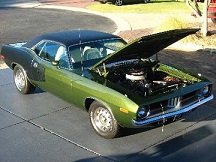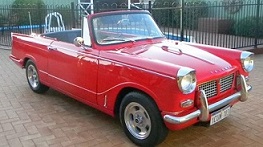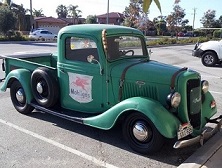|
Author
|
Message
|
|
peeeot
|
|
|
Group: Forum Members
Last Active: Last Year
Posts: 357,
Visits: 25.5K
|
Tonight I hooked up a vacuum gauge to the manifold on my stock '57 312 Fairlane and cruised around at various speeds from 30-70 mph, uphill and downhill, both with and without the vacuum advance hooked up. I wanted to see what difference the timing change would make before I started trying to recurve the distributor.
The distributor is stock and the mechanical curve is close to what the shop manual specifies but the vacuum advance is a bit more aggressive. According to what I have gleaned from this site it's far too much advance. The motor runs well but the fuel economy is pretty sorry (best average so far is 12.5 mpg) and the temperature creeps up to the upper limit of the "normal" bar at speeds of 60 mph and up. Of course, the mpg and temp issues could be caused by bad alignment due to a worn-out front suspension and/or faults in the cooling system, but seeing as the stock advance curve isn't optimized for today's fuel, I thought I'd start there.
What I found was that, in general, disconnecting the vacuum advance resulted in slightly lower vacuum numbers at low speeds (20-40 mph) and slightly higher vacuum readings at highway speeds (55-70 mph). Regardless of speed or presence/absence of vacuum advance, maintaining speed up a moderate grade put the vacuum around 10-13". Accelerating up a grade at highway speeds brought it under 10". Cruising vacuum at my best guess of a level-ground scenario was about 17-18" at most speeds, dropping to more like 15-17.5" at 60-70 mph. Downhills of course brought vacuum over 20" at any speed, if steep enough.
When driving, that needle moves around a lot more than I expected. It was hard to pin down a change with/without the vacuum advance. It seemed to me that, without the advance on the highway, I saw an overall average of about 16.5"Hg as opposed to an average of about 15"Hg with vac adv. At low speeds, average without vac adv was about 16" and with vac adv was closer to 17.5".
So, if manifold vacuum is a good measure of engine efficiency, it seems that the degree of variation in efficiency to be had by making significant changes to the total advance curve is not very large. Now, it's true that my test scenarios were both "extremes"; I'm sure there was too much advance in most instances with the vac adv hooked up and probably less advance than was desirable with it disconnected. Still, even with the optimum curve I wouldn't expect to see a blatantly obvious increase on the numbers I mentioned here. Improvement would be by small degrees moment-by-moment, but I suppose they add up.
For those who've driven with a gauge, do those readings sound consistent with your experience?
|
|
|
|
|
Talkwrench
|
|
|
Group: Forum Members
Last Active: 4 Years Ago
Posts: 898,
Visits: 23.2K
|
|
|
|
|
|
peeeot
|
|
|
Group: Forum Members
Last Active: Last Year
Posts: 357,
Visits: 25.5K
|
Hey Talkwrench, here is a link to a thread where I went through distributor curving a few years ago on a different car I had.
You actually posted in that particular thread and the curve you had sounds pretty similar to mine, with total advance over 50* at higher rpms. Oldcarmark suggests that so much advance will give drivability problems like missing or surging, but I have no such issues. No pinging either.
I still intend to "optimize" my curve as Greenbird describes in that link.
|
|
|
|
|
Talkwrench
|
|
|
Group: Forum Members
Last Active: 4 Years Ago
Posts: 898,
Visits: 23.2K
|
|
|
|
|
|
rick55
|
|
|
Group: Forum Members
Last Active: 5 Years Ago
Posts: 550,
Visits: 4.4K
|
From my experience your vacuum readings whilst driving are unusually high. Idle vacuum should be around 18-20", drive should be around 10-15" and acceleration should be below 10". Deceleration should get up towards high 20's". The power valve in the carburettor is calibrated against the vacuum signal so it opens when's you need the extra fuel.
If you are getting 18" at 70mph your economy should be through the roof. My engine with 280' cam and head work gets around 15" vacuum and who knows when it is running but I get around 17mpg though the imperial gallon is a little bigger than the US gallon. I run it on 91RON with absolutely no sign of pinging at any speed.
Rick - West Australia
Do Y Blocks Downunder run upside down? Gravity Sucks!!
|
|
|
|
|
peeeot
|
|
|
Group: Forum Members
Last Active: Last Year
Posts: 357,
Visits: 25.5K
|
Talkwrench, you say vacuum over 50 degrees at cruise is not uncommon--where are you drawing that knowledge from? I wonder what curves look like for cars of the late 80s/early 90s when manufacturers started using distributorless systems on engine designs that were formerly carbureted.
Rick55, 70 mph was more like 16-17" on level ground but as you say I'd expect at least 14 mpg at that speed. My '62 New Yorker with a 413 did nearly 15 mpg at 70. I really have to wait on the economy expectations until I rebuild the front suspension. Tires are wider than stock too. It's helpful to know that my numbers at least aren't lower than they should be.
1954 Crestline Victoria 312 4-bbl, 3-speed overdrive
|
|
|
|
|
Talkwrench
|
|
|
Group: Forum Members
Last Active: 4 Years Ago
Posts: 898,
Visits: 23.2K
|
Mmm out of my brian ; o ) I remember when doing my Mopar stuff .. Think srcubs might be similar>? Found this. Move on to setting your mechanical advance timing. Insure that the emergency brake is set so no one gets killed. Set the dial of the timing gun to the 35 degree mark, shoot the balancer and slowly bring the engine up to 2500rpm. This will clearly be easier with the extra help of someone sitting in the car to bring the revs up. Turn the distributor until the light falls back down to the 0 degree mark on the balancer. Secure the lockdown on the distributor, tell your buddy to get off the gas, and consider your mechanical advance set. Total timing equals initial plus mechanical, not including vacuum advance (that's why the vacuum is unplugged). So in this example the total advance is "all in" by 2500rpm and for most small block MoPar engines, this is a good place to have it. If initial timing is 17 degrees and mechanical advance (total) timing was set at 35 degrees @ 2500rpm, then: Total timing (35º) = initial (17º) + mechanical (18º) "all in" at 2500rpm. Plug the vacuum hose back into the distributor. You will notice the timing mark shift to well over 50 degrees. It's cool, vacuum advance has just been introduced into the system and its function is to provide extra advance when a vacuum signal is present to improve fuel economy (or so I've been told). Because this is in addition to your initial and mechanical advance (aka your total advance) you notice the degree spike when it's plugged in. The amount of advance can be adjusted by swapping out different vacuum canisters or by putting on an aftermarket adjustable canister. Unless you are a hard core racer, most of the time this is not worth the trouble.
   
"Came too close to dying to stop living now!"
|
|
|
|
|
charliemccraney
|
|
|
Group: Moderators
Last Active: 2 days ago
Posts: 6.1K,
Visits: 442.9K
|
Talk,
The only way to change the rate and amount of mechanical advance is to open the distributor and change the springs and weights. What you have described in the first paragraph merely sets the initial advance. Yes, there will be 35 degrees at 2500rpm but that will not be the max and it will most likely continue to advance if it is a stock distributor.
Lawrenceville, GA
|
|
|
|
|
Talkwrench
|
|
|
Group: Forum Members
Last Active: 4 Years Ago
Posts: 898,
Visits: 23.2K
|
|
|
|
|
|
peeeot
|
|
|
Group: Forum Members
Last Active: Last Year
Posts: 357,
Visits: 25.5K
|
I can imagine that, given a sufficiently slow-burning mixture and combustion chamber design, that 50+ degrees could be suitable for a cruise load on an engine.
What I have noticed in all my web research on this subject is that people have a better grasp on what is needed from the mechanical side than from the vacuum side. The mechanical is a bit more obvious, I think. When an engine is at WOT, too much timing will always make itself known by spark knock or worse. It is advantageous for power and efficiency to give any street engine all the timing it can take at WOT short of spark knocking--that way, all of the expanding power of the mixture is spent pushing the piston in the right direction. I'm not an expert so I'm prepared to be corrected and told that maximum timing short of knocking at WOT is not always the ideal; that's just the understanding that I have to date.
Outside of the WOT scenario, however, things are more complicated, and it is harder to tell whether your spark is igniting the mixture at the optimum time. How big is the cushion for optimum efficiency? Or, put differently, what is the range in degrees of advance within which a given engine at a given speed, load, and throttle percentage will perform the same? Is more vacuum advance always better up to the point that drivability issues become evident? Articles detailing that sort of information are very scarce.
When I disconnected my vacuum advance, I shaved off 24 degrees (!) of advance any time the vacuum port saw 10"Hg or more, which is 95% of the time I was driving. That enormous change resulted in such a small difference at the manifold vacuum gauge that I wasn't really certain whether there WAS a real change, as far as performance/economy. The car didn't really feel different either. Yet, performance, or at least economy, HAS to have been different, as 24* is significant.
1954 Crestline Victoria 312 4-bbl, 3-speed overdrive
|
|
|
|